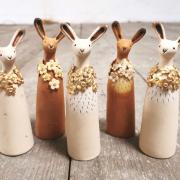This month our columnist is hoping spring will bring the return of some welcome and much-loved visitors
For a decade, perhaps more, the stable yard at the bottom of my garden has been host each spring and summer to three or four pairs of swallows. Mud saucers lined with grass and feathers were built against beams, each home to two or even three broods before the long trek to southern parts in September. The earliest date I recorded for the first pair to arrive was 17 March, the fore-runners of waves of migrants working their way through the countryside in search of previous nesting sites and feeding areas.
However, three seasons ago we were deserted. A pair of swallows inspected the stabling, stayed a day or two and then vanished. It was the same story last year and though the old spider-webbed nests still clung to the beams, they remained untenanted. Yet swallows and house martins patronised neighbours, albeit in smaller numbers than previously, though the telephone wires were heavy with departing birds in the early autumn as they gathered for their mass migration to Africa, India and western Asia.
So, this year I am hoping that late March or April will see a pair of barn swallows once again seeking to nest in the stable. There is normally a plentiful supply of mud in the adjacent field for basic building material and no lack of insect life. Once again, I hope to see the birds streaking through the air, looping and swerving with open beaks as they feed on gnats and flies, uttering their twittering cries, while speeding through the open stable door at 40mph to loop up to a nest.
As is so often the case with a bird which is so familiar and dependent on man’s works, it has attracted myths and legends, perhaps the most notable being the failure of our forefathers to understand the implications of migration. Many believed that swallows hid themselves in holes and crevices during the winter, a belief which was tentatively shared by the 18th century naturalist Gilbert White of Selborne, while Dr Johnson stoutly asserted that “a number of them conglobulate together by flying round and round and then, all in a heap, throw themselves under water and lie in the bed of a river”.
It was also believed amongst country folk that to kill a swallow or destroy its nest would invariably bring ill luck, whilst a swallow tumbling down a Yorkshire chimney was a portent of death; in Norfolk a large flock of swallows gathering round a house was a certain sign that someone there was going to die and their soul would leave with the birds. On the other hand swallows nesting on one’s house was thought to be a sign of good fortune.
The only two other members of the swallow family which patronise our country are the sand martin and house martin, and though many folk believe that the swift is a type of swallow, yet despite its superficial appearance it is not related to this family. The little brown sand martin is, in fact, more likely to appear in this country before the swallow and not infrequently is identified as “the first swallow to arrive”. House martins, too, although blue-black with a white chest and rump and lacking the long tail streamers of the swallow, are also sometime misidentified. However, like swallows they too are closely associated with man, nesting under house eaves, often in close and companionable association with each other, a reminder of the time, before man’s dwellings, when they nested on cliffs and rocks.
So let’s hope that March, the first month I associate with spring and the approaching summer months will bring with it swallows and martins in abundance…and please let me have at least one pair of the former. The old nests are waiting to be filled!



























